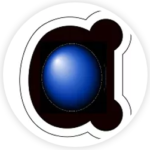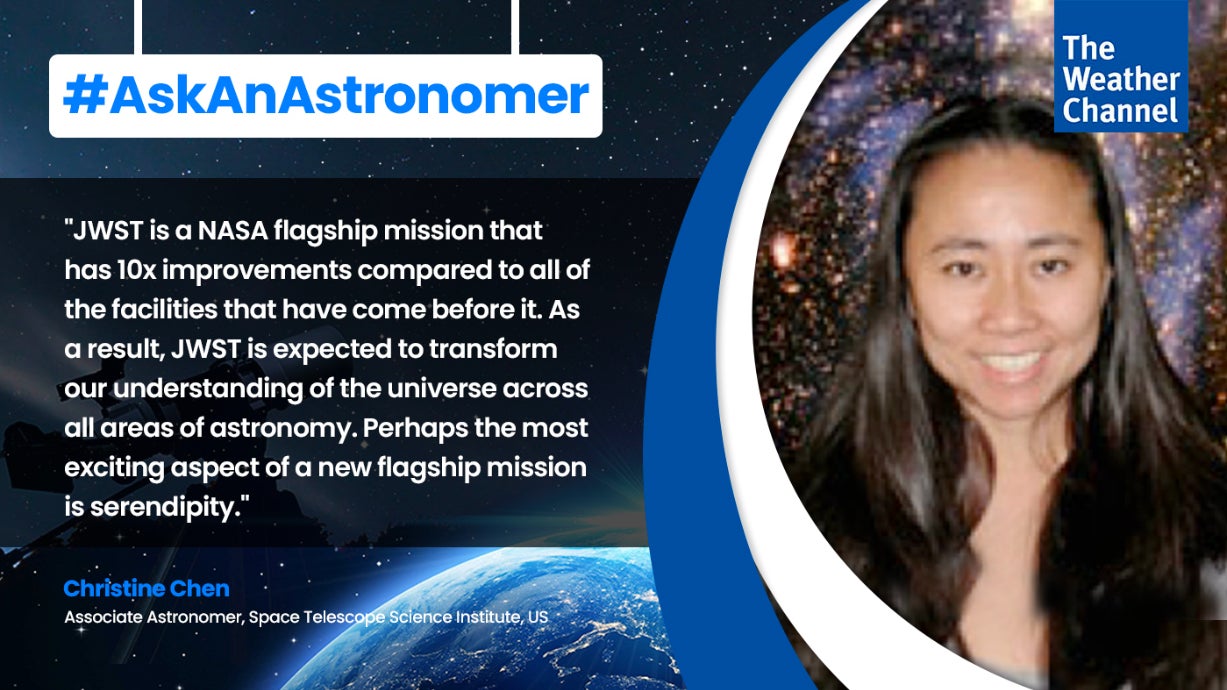Ask An Astronomer: Dr Christine Chen on James Webb Space Telescope Launch, Optical Astronomy, and More | The Weather Channel – Articles from The Weather Channel


How the first galaxies formed, how the first light emerged post-Big Bang, how many planets lie in the habitable zone, does life exist beyond Earth? The universe is full of mysteries, and as we know more our never-ending curiosity poses a whole new set of questions!
Try Adsterra Earnings, it’s 100% Authentic to make money more and more.

Yet, we are about to take a significant step towards unravelling some of these mysteries! An incredible army of astronomers and engineers has developed a powerhouse of space exploration—the James Webb Space Telescope (JWST). It will give space scientists the wealth of never-before-seen cosmic data about the universe.
But before that, the JWST has to survive a fiery voyage of around a million and a half kilometres into space before finally reaching its designated location i.e., Lagrange point L2.
As we drive closer to the launch day, The Weather Channel got in touch with Dr Christine Chen, an associate astronomer at Space Telescope Science Institute (STScI) in Maryland, United States. Her interest lies in studying the formation and evolution of planetary systems and is one of the future users of the JWST Mid Infrared Instrument (MIRI).
Here’s what Dr Chen has to say on one of the most ambitious science and engineering projects that humankind has ever attempted!
James Webb Space Telescope (JWST) is dubbed to be the most powerful telescope, surpassing its predecessor, Hubble. What makes this telescope so powerful?
When it launches, JWST will be the largest telescope ever launched into space. The diameter of JWST’s primary mirror (6.6 m) surpasses that of Hubble (2.6 m) and is more similar to that of today’s large, ground-based observatories (8 m). As such, JWST combines the best of a large telescope that can see fine detail and a sensitive, stable telescope in space.
During the first year of JWST operations, it will stare at dark regions of the sky such as the Hubble Deep Field and be able to see galaxies at greater distances than ever before. In addition, it will be able to study the properties of rocky planets and giant planets as well as the environments in which these planets form and evolve.


How is it different from Hubble? What are the primary objectives of launching JWST?
The two most important differences between Hubble and JWST are primary mirror size and the wavelengths at which the instruments operate. The JWST primary mirror has a diameter of 6.6 m, significantly larger than the 2.6 m diameter of the Hubble primary mirror. The larger size means that JWST can collect more light than Hubble; therefore, it is expected to be more sensitive to faint, distant objects. The JWST instruments operate at infrared wavelengths (0.6 – 28 micron), significantly longer wavelengths than the Hubble instruments (0.1 – 1.6 micron).
Tell us a bit about optical astronomy? How JWST will aid observation and analysis of various light sources, especially the first light?


JWST is designed to observe infrared light—wavelengths of light that are beyond the rainbow visible to human eyes. Infrared light’s longer wavelengths provide information that other wavelengths cannot, including star formation.
((NASA and J. Olmstead STScI))JWST observes the universe in the infrared, in-between the wavelengths our eyes can see with Hubble and longer wavelengths that probe the cold universe that the Atacama Large Millimeter Array (ALMA) is sensitive to. The infrared capability will allow JWST to peer inside dusty regions of galaxies, detect the heat radiated by terrestrial and giant planets, and detect spectral lines emitted from molecules that are key to life on Earth (H2O, CO, CO2 and methane).
Moreover, the infrared capability will enable observations of the first stars and galaxies that formed after the Big Bang. Hubble’s Law tells us that the speed at which galaxies are flying away from us increases with their distance from us. JWST will be able to detect and characterize the visual light from the first galaxies that have been redshifted into the infrared because they are moving away from us at such tremendous speeds.
Please tell us about the launch specifications. What is the most challenging part from the launch to reaching the designated orbit?
JWST has many critical and complex activities that it must successfully complete before reaching its designated orbit. The Arianne 5 must carefully insert JWST onto a trajectory that will take it past the Moon’s orbit and to L2.
JWST uses a solar array to generate the electricity needed to operate the instruments, a cryocooler to cool the MIRI instrument, and a sunshield to protect JWST from the Sun, Earth, and Moon.
In addition, JWST has not only a primary mirror that collects light from the universe but also a secondary mirror that redirects the light to the instruments. The sunshield, secondary mirror support structure, and primary mirror are so large that they are also carefully folded up to fit within the Arianne 5 fairing. Therefore, all of these structures must be unfurled before the telescope can begin commissioning at L2.
Unlike Hubble, JWST would be placed in the Lagrange point or L2? Why was this location chosen?


Webb will orbit the second Lagrange point (L2), 1.5 million kilometres from Earth in the direction away from the Sun.
(ESA)Hubble is in Low Earth Orbit at an altitude of about 340 miles above the surface of the Earth. At this height, Hubble is above Earth’s atmosphere. JWST, however, needs to be kept much cooler than Hubble to observe at infrared wavelengths. If JWST were in the same orbit as Hubble, then the heat from the Earth and Moon would heat up the telescope that makes detecting faint objects challenging.
JWST has a tennis court-sized sunshield that the telescope will use to shade it from bright objects. At L2, the Sun, Earth, and JWST will always be in a straight line. As a result, JWST can use its sunshield to block out the light and heat from the Sun, Earth and Moon at the same time.
How will the telescope protect itself from the harsh environment of the Sun?
JWST has a five-layer, tennis court-size sunshield to protect it from the Sun. Five layers are needed to successively cool the area behind the sunshade to a temperature of about 40 K. If the telescope was not shaded, then it would have a temperature of about 300 K. At such warm temperatures, the telescope itself would radiate so much heat that it would swamp out the fainter astrophysical sources that scientists are trying to study.
The Midinfrared Instrument (MIRI) operates at the longest wavelengths and therefore must be kept the coldest. MIRI has a cryocooler that will cool the instrument down even more to about 7K.
Please tell us about some of the major features of the telescope.


JWST’s golden mirror.
(NASA/Chris Gunn)My favourite feature of the telescope might be the multi-segmented primary mirror. JWST’s primary mirror is actually composed of 18 hexagonal segments that work together in concert like a single, monolithic mirror. The hexagonal segments make it possible to fold the 6.6 m telescope to fit inside the Arianne 5 fairing.
The shape of each mirror segment can be individually controlled to make sure that the telescope is in focus. As a result, JWST shouldn’t suffer from the same spherical aberration problems that Hubble did.
What are you, personally, planning to explore through this telescope?
I personally am interested in understanding how exoplanetary systems form and evolve. During the first year of operations, I am planning to observe the exoplanetary system beta Pictoris. Beta Pictoris is host not only to two giant planets but also a Kuiper Belt that is believed to be the source of exocomets.
I am hoping to learn if there are silicate clouds in the atmosphere of the exoplanet Beta Pictoris b and whether beta Pictoris b affects the evolution of the leftover planetesimals in the planetary system.
How will this new generation telescope help advance our understanding of the cosmic world?


Artist’s impression of NASA’s James Webb Space Telescope.
(NASA)JWST is a NASA flagship mission that has 10x improvements compared to all of the facilities that have come before it. As a result, JWST is expected to transform our understanding of the universe across all areas of astronomy. Perhaps the most exciting aspect of a new flagship mission is serendipity. The universe is more weird and wonderful than astronomers can imagine so we expect, as with other previous missions, we will discover things about the universe that we hadn’t imagined before.
The interview is a part of a series titled Ask An Astronomer. The opinions of the expert do not necessarily represent the official views of The Weather Channel.
**
For weather, space science, and COVID-19 updates on the go, download The Weather Channel App (on Android and iOS store). It’s free!
More Story on Source:
*here*
Ask An Astronomer: Dr Christine Chen on James Webb Space Telescope Launch, Optical Astronomy, and More | The Weather Channel – Articles from The Weather Channel
Published By

Latest entries
 allPost2025.01.31‘It’s devastating’: Olympic champion Brian Boitano mourns loss of friends in D.C. crash
allPost2025.01.31‘It’s devastating’: Olympic champion Brian Boitano mourns loss of friends in D.C. crash allPost2025.01.31Trump administration tells top FBI officials to resign or be fired
allPost2025.01.31Trump administration tells top FBI officials to resign or be fired allPost2025.01.31At 10 years old, this skater who died in D.C. plane crash had Olympic dreams
allPost2025.01.31At 10 years old, this skater who died in D.C. plane crash had Olympic dreams allPost2025.01.31Phil E.the chinchilla is a social media sensation with millions of fans
allPost2025.01.31Phil E.the chinchilla is a social media sensation with millions of fans




